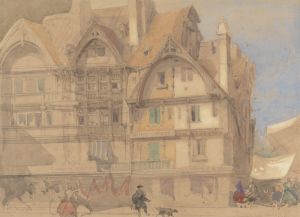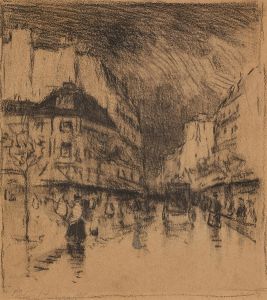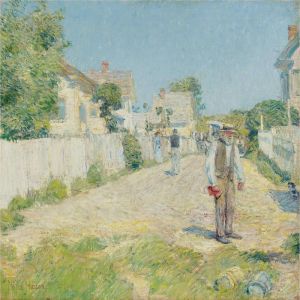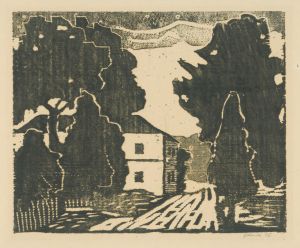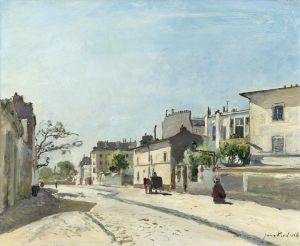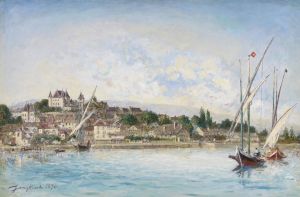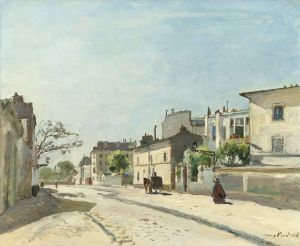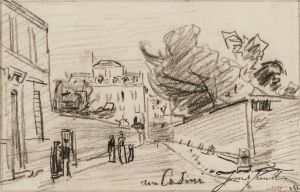
La Rue Saint-Jacques, Paris
A hand-painted replica of Johan Barthold Jongkind’s masterpiece La Rue Saint-Jacques, Paris, meticulously crafted by professional artists to capture the true essence of the original. Each piece is created with museum-quality canvas and rare mineral pigments, carefully painted by experienced artists with delicate brushstrokes and rich, layered colors to perfectly recreate the texture of the original artwork. Unlike machine-printed reproductions, this hand-painted version brings the painting to life, infused with the artist’s emotions and skill in every stroke. Whether for personal collection or home decoration, it instantly elevates the artistic atmosphere of any space.
Johan Barthold Jongkind was a Dutch painter known for his significant contributions to the development of Impressionism. He was born on June 3, 1819, in Lattrop, Netherlands, and spent much of his career in France. Jongkind is particularly celebrated for his landscapes and cityscapes, which often depicted scenes from Paris and its surroundings. His work is characterized by a keen observation of light and atmosphere, which influenced many Impressionist painters, including Claude Monet.
One of Jongkind's notable works is "La Rue Saint-Jacques, Paris." This painting captures a scene from one of the oldest streets in Paris, Rue Saint-Jacques, which runs through the Latin Quarter. The street is historically significant, having been a major thoroughfare in the city since Roman times. It was named after the pilgrims who traveled along it to reach the Church of Saint-Jacques-la-Boucherie, a starting point for the pilgrimage to Santiago de Compostela in Spain.
Jongkind's depiction of Rue Saint-Jacques reflects his ability to convey the bustling life of Paris through his brushwork and use of color. The painting likely captures the essence of the street during the mid-19th century, a period when Paris was undergoing significant changes under the direction of Baron Haussmann. Haussmann's renovation of Paris transformed many parts of the city, introducing wide boulevards and modern infrastructure, although Rue Saint-Jacques retained much of its historical character.
In "La Rue Saint-Jacques, Paris," Jongkind employs his signature style, which includes loose brushstrokes and a focus on the effects of light. This approach allows him to create a sense of movement and vitality, capturing the dynamic atmosphere of the street. His palette often includes soft, muted colors that evoke the mood of the scene, whether it be a sunny day or a more overcast moment.
Jongkind's work was instrumental in bridging the gap between the Barbizon School and the Impressionists. While the Barbizon painters focused on naturalistic landscapes, Jongkind introduced a more spontaneous and fluid technique that emphasized the changing qualities of light and weather. This approach resonated with the Impressionists, who sought to capture fleeting moments and the sensory experiences of their environments.
"La Rue Saint-Jacques, Paris" is a testament to Jongkind's skill in rendering urban landscapes with a sense of immediacy and emotion. His ability to depict the interplay of light and shadow, as well as his attention to architectural details, makes this painting a valuable representation of 19th-century Parisian life. Jongkind's influence on Impressionism is evident in the works of artists like Monet, who admired his innovative techniques and his dedication to capturing the essence of a scene.
Throughout his career, Jongkind exhibited his works in various salons and gained recognition for his contributions to the art world. Despite facing personal challenges, including struggles with alcoholism, he remained a dedicated artist until his death on February 9, 1891, in La Côte-Saint-André, France. Today, Jongkind's paintings, including "La Rue Saint-Jacques, Paris," continue to be celebrated for their pioneering approach and their role in shaping the course of modern art.






